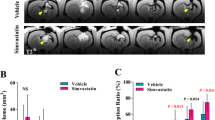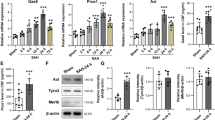Abstract
As one of the main types of secondary craniocerebral injury, the onset, progression, and prognosis of chronic subdural hematoma (CSDH) are closely related to the local inflammation of intracranial hematoma. Atorvastatin is reported to be effective in the conservative treatment of CSDH. This study aimed to clarify whether atorvastatin regulated the inflammatory responses in CSDH by interfering with the function of macrophages. The rat CSDH model was prepared by repeated intracranial blood injection with velocity gradient, and MRI was applied to calculate the intracranial hematoma volume. Changes in rat nerve functions were evaluated by foot-fault and Morris water maze tests. Flow cytometry was applied to detect the number of total macrophages and the percentage of M1 or M2 macrophages. The expression of inflammatory factors was examined by ELISA and western blot. Western bolt was applied to detect the expression of proteins involved in the colony-stimulating factor 1 receptor (CSF-1R) signaling pathway. Our results showed that atorvastatin significantly accelerated the absorption of hematoma and improved the nerve functions of CSDH rats. In addition, atorvastatin treatment effectively suppressed the expression of TNF-α, IL-6, and IL-8 and promoted the expression of IL-10. The total number of macrophages was decreased, and the percentage of M2 macrophages was increased in the intracranial hematoma following atorvastatin treatment. Furthermore, atorvastatin increased the levels of M2-related genes and surface markers in BMDMs stimulated by lipopolysaccharides and IFNγ, and activated the CSF-1R signaling pathway. In conclusion, our study shows that atorvastatin could alleviate the symptoms of CSDH and promote hematoma ablation by polarizing macrophages to M2 type and regulating the inflammatory responses.




Similar content being viewed by others
Availability of Data and Materials
Data is available from the authors by request.
References
Abecassis IJ, Kim LJ (2017) Craniotomy for treatment of chronic subdural hematoma. Neurosurg Clin N Am 28:229–237. https://doi.org/10.1016/j.nec.2016.11.005
Adhiyaman V, Chattopadhyay I, Irshad F, Curran D, Abraham S (2017) Increasing incidence of chronic subdural haematoma in the elderly. QJM 110:375–378. https://doi.org/10.1093/qjmed/hcw231
Chistiakov DA, Myasoedova VA, Revin VV, Orekhov AN, Bobryshev YV (2018) The impact of interferon-regulatory factors to macrophage differentiation and polarization into M1 and M2 Immunobiology 223:101–111. https://doi.org/10.1016/j.imbio.2017.10.005
Edlmann E, Giorgi-Coll S, Whitfield PC, Carpenter KLH, Hutchinson PJ (2017) Pathophysiology of chronic subdural haematoma: inflammation, angiogenesis and implications for pharmacotherapy J Neuroinflammation 14:108. https://doi.org/10.1186/s12974-017-0881-y
Hong HJ, Kim YJ, Yi HJ, Ko Y, Oh SJ, Kim JM (2009) Role of angiogenic growth factors and inflammatory cytokine on recurrence of chronic subdural hematoma Surg Neurol 71:161-165; discussion 165–166. https://doi.org/10.1016/j.surneu.2008.01.023
Jiang R et al. (2015) Effect of ATorvastatin On Chronic subdural Hematoma (ATOCH): a study protocol for a randomized controlled trial Trials 16:528. https://doi.org/10.1186/s13063-015-1045-y
Juratli TA, Klein J, Schackert G (2017) [Chronic subdural hematoma in the elderly] Chirurg 88:131–135. https://doi.org/10.1007/s00104-016-0343-6
Kelleher FC, O'Sullivan H (2017) Monocytes, macrophages, and osteoclasts in osteosarcoma J Adolesc Young Adult Oncol 6:396–405. https://doi.org/10.1089/jayao.2016.0078
Kogawa AC, Pires A, Salgado HRN (2019) Atorvastatin: a review of analytical methods for pharmaceutical quality control and monitoring J AOAC Int 102:801–809 https://doi.org/10.5740/jaoacint.18-0200
Kutty SA, Johny M (2014) Chronic subdural hematoma: a comparison of recurrence rates following burr-hole craniostomy with and without drains. Turk Neurosurg 24:494–497. https://doi.org/10.5137/1019-5149.JTN.8830-13.1
Li T et al (2014) Effects of atorvastatin on the inflammation regulation and elimination of subdural hematoma in rats. J Neurol Sci 341:88–96. https://doi.org/10.1016/j.jns.2014.04.009
Liu H, Luo Z, Liu Z, Yang J, Kan S (2016) Atorvastatin may attenuate recurrence of chronic subdural hematoma Front Neurosci 10:303. https://doi.org/10.3389/fnins.2016.00303
Majovsky M, Netuka D (2018) Chronic subdural hematoma—review article Rozhl Chir 97:253–257
Mills CD (2015) Anatomy of a discovery: m1 and m2 macrophages Front Immunol 6:212. https://doi.org/10.3389/fimmu.2015.00212
Prasad GL (2017) Outcomes and recurrences after chronic subdural hematoma evacuation World Neurosurg 106:979. https://doi.org/10.1016/j.wneu.2017.05.047
Qiu S, Zhuo W, Sun C, Su Z, Yan A, Shen L (2017) Effects of atorvastatin on chronic subdural hematoma: a systematic review. Medicine (Baltimore) 96:e7290. https://doi.org/10.1097/MD.0000000000007290
Quan W et al (2019) Role of regulatory T cells in atorvastatin induced absorption of chronic subdural hematoma in rats Aging Dis 10:992–1002. https://doi.org/10.14336/AD.2018.0926
Quan W et al (2015) A rat model of chronic subdural hematoma: insight into mechanisms of revascularization and inflammation. Brain Res 1625:84–96. https://doi.org/10.1016/j.brainres.2015.08.017
Rodriguez-Perea AL, Gutierrez-Vargas J, Cardona-Gomez GP, Guarin CJ, Rojas M, Hernandez PA (2017) Atorvastatin modulates regulatory T cells and attenuates cerebral damage in a model of transient middle cerebral artery occlusion in rats. J Neuroimmune Pharmacol 12:152–162. https://doi.org/10.1007/s11481-016-9706-5
Santarius T, Hutchinson PJ (2004) Chronic subdural haematoma: time to rationalize treatment? Br J Neurosurg 18:328–332. https://doi.org/10.1080/02688690400004845
Tanaka Y, Ohno K (2013) Chronic subdural hematoma—an up-to-date concept J Med Dent Sci 60:55–61
Tang R et al (2018) Effects of atorvastatin on surgical treatments of chronic subdural hematoma World Neurosurg 117:e425–e429. https://doi.org/10.1016/j.wneu.2018.06.047
Tao Z, Lin Y, Hu M, Ding S, Li J, Qiu Y (2016) Mechanism of subdural effusion evolves into chronic subdural hematoma: IL-8 inducing neutrophil oxidative burst Med Hypotheses 86:43–46. https://doi.org/10.1016/j.mehy.2015.11.027
Uno M, Toi H, Hirai S (2017) Chronic subdural hematoma in elderly patients: is this disease benign? Neurol Med Chir (Tokyo) 57:402–409. https://doi.org/10.2176/nmc.ra.2016-0337
Wang D et al (2014) Effects of atorvastatin on chronic subdural hematoma: a preliminary report from three medical centers. J Neurol Sci 336:237–242. https://doi.org/10.1016/j.jns.2013.11.005
Yadav YR, Parihar V, Namdev H, Bajaj J (2016) Chronic subdural hematoma Asian J Neurosurg 11:330–342. https://doi.org/10.4103/1793-5482.145102
Yang W, Huang J (2017) Chronic subdural hematoma: epidemiology and natural history. Neurosurg Clin N Am 28:205–210. https://doi.org/10.1016/j.nec.2016.11.002
Zhang XW, Wu Y, Wang DK, Jin X, Li CH (2019) Expression changes of inflammatory cytokines TNF-alpha, IL-1beta and HO-1 in hematoma surrounding brain areas after intracerebral hemorrhage J Biol Regul Homeost Agents 33:1359–1367. https://doi.org/10.23812/19-150-A
Zhang YH, He M, Wang Y, Liao AH (2017) Modulators of the balance between M1 and M2 macrophages during pregnancy Front Immunol 8:120. https://doi.org/10.3389/fimmu.2017.00120
Zumofen D, Regli L, Levivier M, Krayenbuhl N (2009) Chronic subdural hematomas treated by burr hole trepanation and a subperiostal drainage system Neurosurgery 64:1116-1121; discussion 1121–1112. https://doi.org/10.1227/01.NEU.0000345633.45961.BB
Funding
The study was supported by the Beijing Tianjin Hebei Basic Research Cooperation Project (19JCZDJC64600(Z)) and the National Key Research and Development Program of China (2017YFE0110400).
Author information
Authors and Affiliations
Contributions
Liang Yang: data curation, data analysis, drafting of the article, and final approval of the version to be published. Nan Li: data curation, data analysis, drafting of the article, and final approval of the version to be published. Lijun Yang: data curation, data analysis, drafting of the article, and final approval of the version to be published. Dong Wang: data curation, data analysis, drafting of the article, and final approval of the version to be published. Shuke Qiang: data curation, data analysis, drafting of the article, and final approval of the version to be published. Zongmao Zhao: study supervision, coordination, funding support, design of this study, drafting of the article, and final approval of the version to be published.
Corresponding author
Ethics declarations
Ethics Approval and Consent to Participate
Animal studies were reviewed and approved by the Ethics Committee of the Second Hospital of Hebei Medical University.
Consent for Publication
Current study is available from the corresponding author on reasonable request.
Competing Interests
The authors declare no competing interests.
Additional information
Publisher's Note
Springer Nature remains neutral with regard to jurisdictional claims in published maps and institutional affiliations.
Supplementary Information
Below is the link to the electronic supplementary material.
Rights and permissions
About this article
Cite this article
Yang, L., Li, N., Yang, L. et al. Atorvastatin-Induced Absorption of Chronic Subdural Hematoma Is Partially Attributed to the Polarization of Macrophages. J Mol Neurosci 72, 565–573 (2022). https://doi.org/10.1007/s12031-021-01910-x
Received:
Accepted:
Published:
Issue Date:
DOI: https://doi.org/10.1007/s12031-021-01910-x




